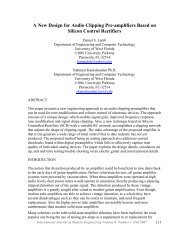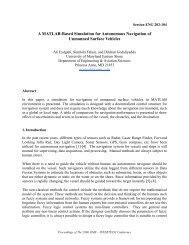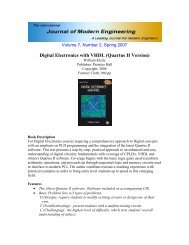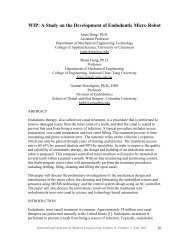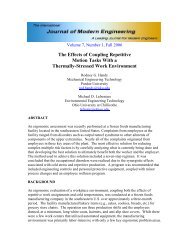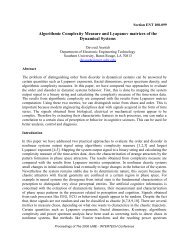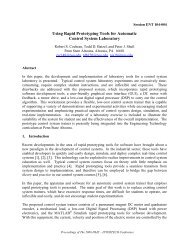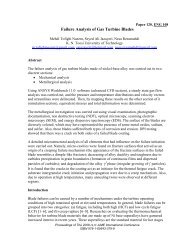Design and Testing of a Permanent Magnet Axial Flux Wind ... - IJME
Design and Testing of a Permanent Magnet Axial Flux Wind ... - IJME
Design and Testing of a Permanent Magnet Axial Flux Wind ... - IJME
Create successful ePaper yourself
Turn your PDF publications into a flip-book with our unique Google optimized e-Paper software.
<strong>of</strong>fs. Typically, empirical relations or simplified models are used in the early stages <strong>of</strong> the<br />
design, followed by finite element analysis (FEA) in the later stages. In either case,<br />
calculation <strong>of</strong> the airgap magnetic field is <strong>of</strong> utmost importance because it is required for the<br />
calculation <strong>of</strong> performance metrics, such as torque constant, torque ripple, back emf constant,<br />
<strong>and</strong> back emf waveshape.<br />
Calculation <strong>of</strong> the airgap magnetic field using FEA is quite time consuming, especially for an<br />
axial flux permanent magnet machine, since 3-D FEA is generally required. As a result,<br />
analytical methods to obtain magnetic field solutions have been presented in the literature for<br />
permanent magnet synchronous machines <strong>of</strong> radial flux [1, 2], linear [3, 4], <strong>and</strong> axial flux<br />
configuration [5, 6, 7]. However, solutions proposed for axial flux machines [8, 9, 10] use a<br />
mean radius approach, which limits the accuracy <strong>of</strong> the solution for machines whose relative<br />
magnet width or stator coil width is a function <strong>of</strong> stator radius.<br />
In this paper, the magnetic field distribution in a two-rotor, permanent magnet, ironless stator<br />
axial field generator for direct-drive wind energy conversion is studied. The goal is to<br />
develop the analytical model for the machine that will facilitate timely design trade-<strong>of</strong>f<br />
studies <strong>and</strong> support an overall electro-mechanical model <strong>of</strong> energy conversion system. The<br />
model will also consider machine designs where magnet <strong>and</strong> coil width relative to the pole<br />
pitch varies with the machine radius. Analytical results will be validated through a<br />
combination <strong>of</strong> finite element analysis (FEA) <strong>and</strong> a series <strong>of</strong> experiments to demonstrate the<br />
usefulness <strong>of</strong> the proposed method.<br />
2. <strong>Permanent</strong> <strong>Magnet</strong> <strong>Axial</strong> <strong>Flux</strong> Machines<br />
<strong>Axial</strong> flux machines are formed by a rotor disc carrying magnets that produce an axial flux<br />
<strong>and</strong> a stator disc containing the phase windings. Many variations in this basic design are<br />
possible, including single-sided [11], double-sided [12], torus [13, 14], <strong>and</strong> multi-disc<br />
designs [15]. This paper focuses on the two-rotor, one stator topology, where a single stator<br />
is placed between two permanent magnet (PM) rotor discs, as shown in Figure 1. This figure<br />
shows a view looking inward radially. Figure 2 shows rotor <strong>and</strong> stator views looking in the<br />
axial direction.<br />
The two disc shaped rotors <strong>of</strong> Figure 1 carry axially magnetized, surface mounted NDFeB<br />
magnets on their inner surfaces. The magnets on opposing rotor discs are arranged so that a<br />
North pole on one rotor faces a South pole on the other, resulting in an axial magnetic field<br />
so that stator yoke is not required (stator is required for N-N facing magnets). In the absence<br />
<strong>of</strong> stator iron, three-phase coils are typically potted in a resin. This construction has several<br />
advantages over other topologies, such as ease <strong>of</strong> manufacture, reduced iron losses, <strong>and</strong> no<br />
cogging torque. The double-rotor, single stator axial flux machine also has relatively high<br />
moment <strong>of</strong> inertia, allowing energy to be stored in the rotating machine to help smooth power<br />
output during transients.<br />
3. Analytical Model <strong>of</strong> <strong>Axial</strong> PM Machine<br />
To analyze the magnetic field in the airgap <strong>of</strong> the axial PM machine, computations based on<br />
the work in reference [6] are applied. However, the analytic model presented in reference [6]<br />
Proceedings <strong>of</strong> The 2008 IAJC-<strong>IJME</strong> International Conference<br />
ISBN 978-1-60643-379-9



